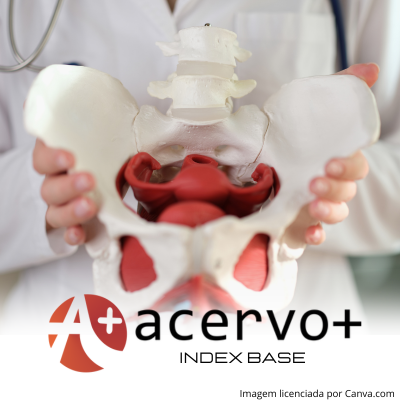Doença Inflamatória Pélvica
##plugins.themes.bootstrap3.article.main##
Resumo
Objetivo: Analisar as características da Doença Inflamatória Pélvica (DIP). Revisão bibliográfica: A DIP é uma inflamação do trato genital superior que afeta 4% a 12% das mulheres em idade reprodutiva. Normalmente é uma infecção ascendente, espalhando-se a partir do trato genital inferior. A maioria dos casos de IDP está relacionada a uma infecção sexualmente transmissível. A DIP configura um problema clínico e de saúde pública devido ao seu potencial para resultar em infertilidade em casos não diagnosticados ou mal tratados. Esta complicação afeta uma em cada oito mulheres com história de DIP. Além disso, a DIP está associada a outras morbidades, como dor pélvica crônica, gravidez ectópica. Considerações finais: A DIP é um grave problema de saúde pública devido à sua alta morbidade e consequências como a infertilidade. Seu diagnóstico é clinico e dificultado pela ampla gama de sintomas. O tratamento perpassa primeiramente pela avaliação da necessidade ou não de internação hospitalar, pela rápida introdução de antibióticos seja em regime hospitalar ou ambulatorial, controle álgico com antiinflamatórios não esteróides, educação em saúde e tratamento dos parceiros sexuais a fim de evitar reinfecções.
##plugins.themes.bootstrap3.article.details##
Copyright © | Todos os direitos reservados.
A revista detém os direitos autorais exclusivos de publicação deste artigo nos termos da lei 9610/98.
Reprodução parcial
É livre o uso de partes do texto, figuras e questionário do artigo, sendo obrigatória a citação dos autores e revista.
Reprodução total
É expressamente proibida, devendo ser autorizada pela revista.
Referências
2. CHARVERIAT A, FRITEL X. Diagnosis of pelvic inflammatory disease: Clinical, paraclinical, imaging and laparoscopy criteria. CNGOF and SPILF Pelvic Inflammatory Diseases Guidelines. Gynecol Obstet Fertil Senol, 2019; 47(5): 404-408.
3. CURRY A, et al. Pelvic Inflammatory Disease: Diagnosis, Management, and Prevention. Am Fam Physician, 2019; 100(6): 357-364.
4. DARVILLE T. Pelvic Inflammatory Disease Due to Neisseria gonorrhoeae and Chlamydia trachomatis: Immune Evasion Mechanisms and Pathogenic Disease Pathways. J Infect Dis, 2021; 224(12): 39-46.
5. HE D, et al. Global burden of pelvic inflammatory disease and ectopic pregnancy from 1990 to 2019. BMC Public Health, 2023; 23(1): 1894.
6. HILLIER SL, et al. A Review of the Challenges and Complexities in the Diagnosis, Etiology, Epidemiology, and Pathogenesis of Pelvic Inflammatory Disease. J Infect Dis, 2021; 224(12): 23-28.
7. HUNT S, VOLLENHOVEN B. Pelvic inflammatory disease and infertility. Aust J Gen Pract, 2023; 52(4): 215-218.
8. IWATA H, et al. Diagnostic accuracy of pelvic examination in pelvic inflammatory disease: A meta-analysis. J Gen Fam Med, 2022; 23(6): 384-392.
9. MAIA JRS, et al. FATORES QUE DETERMINAM O DESENVOLVIMENTO DA DOENÇA INFLAMATÓRIA PÉLVICA. DêCiência em Foco, 2021; 5(1): 77 - 89.
10. MARCINKOWSKI KA, et al. Pelvic inflammatory disease in pregnancy: a systematic review focusing on perinatal outcomes. Am J Obstet Gynecol MFM, 2022; 4(4): 100643.
11. MENEZES MLB, et al. Brazilian Protocol for Sexually Transmitted infections, 2020: pelvic inflammatory disease. Rev Soc Bras Med Trop, 2021; 54(1): e2020602.
12. MITCHELL CM, et al. Etiology and Diagnosis of Pelvic Inflammatory Disease: Looking Beyond Gonorrhea and Chlamydia. J Infect Dis, 2021; 224(12): 29-35.
13. RAVEL J, et AL. Bacterial vaginosis and its association with infertility, endometritis, and pelvic inflammatory disease. Am J Obstet Gynecol, 2021; 224(3): 251-257.
14. RIBEIRO KE, et al. Acute pelvic inflammatory diseases: approach to etiological aspects and pharmacological treatment. RSD, 2022; 11(10): e111111032485.
15. RODRIGUES R, et al. Chlamydial and Gonococcal Genital Infections: A Narrative Review. J Pers Med, 2023; 13(7): 1170.
16. SAVARIS RF, et al. Antibiotic therapy for pelvic inflammatory disease. Cochrane Database Syst Rev, 2020; 8(8): CD010285.
17. SAVARIS RF. Up-to-date data on Pelvic Inflammatory Disease. Rev Soc Bras Med Trop, 2021; 54: e0419.
18. SCHEER IO, et al. Abordagem da doença inflamatória pélvica: uma revisão de literatura. Brazilian Journal of Health Review, 2021; 4 (1): 169-187.
19. SILVA LS, et al. Abordagens clínicas da doença inflamatória pélvica- uma revisão de literatura. Brazilian Journal of Health Review, 2023; 6(5): 23839-23847.
20. SWEENEY S, et al. Factors associated with pelvic inflammatory disease: A case series analysis of family planning clinic data. Womens Health (Lond), 2022;18: 17455057221112263.
21. YUSUF H, TRENT M. Management of Pelvic Inflammatory Disease in Clinical Practice. Ther Clin Risk Manag, 2023; 19: 183-192.
22. XU SX, GRAY-OWEN SD. Gonococcal Pelvic Inflammatory Disease: Placing Mechanistic Insights into the Context of Clinical and Epidemiological Observations. J Infect Dis, 2021; 224(12): 56-63.
23. WANG D, et al. Evidence for the Use of Complementary and Alternative Medicine for Pelvic Inflammatory Disease: A Literature Review. Evid Based Complement Alternat Med, 2022; 2022:1364297.

